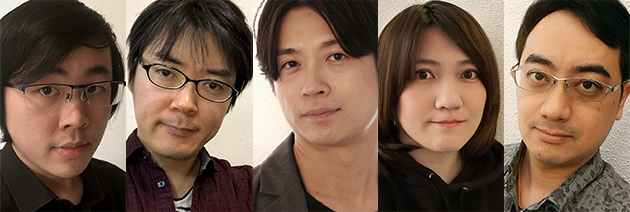
The Making of CODE VEIN (Part 2) presents stories from the project’s very beginnings to its early phases of development, offering a peek into the creation of the drama-laced action-adventure RPG that received global acclaim.
Participants were interviewed in an online discussion over Zoom. (Held January 2021.)
CODE VEIN’s Development Staff
| Hiroshi Yoshimura | Game Designer/CODE VEIN Director, Development Producer |
|---|---|
| Yuichi Yoda | Game Designer/CODE VEIN Director, primarily Action Supervisor |
| Koichi Itakura | Artist/CODE VEIN Art Director, Dungeon Building Supervisor |
| Kurumi Kobayashi | Artist/CODE VEIN Character Designer, also initial Art Director |
| Dun Mao | Game Designer/CODE VEIN Planner, Game Balance, Localization, and Global Communication Supervisor |
Designing Actions for Combat
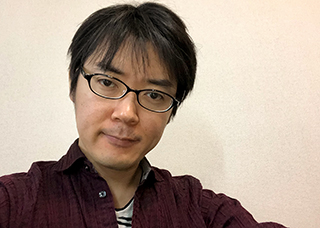
● Yuichi Yoda
Game Designer/CODE VEIN Director, primarily Action Supervisor
●Yoda: For this title, we took a completely different approach to animating the combat actions. In GOD EATER, animation was generally handled by animators, but in CODE VEIN we used motion capture for about ninety percent of the work.
Motion capture is pretty widely used in the gaming industry, but I had never used it before and it ended up being a refreshing experience.
Of course we ran into trouble that you wouldn’t encounter using other techniques… But motion capture makes characters’ subtle mannerisms appear even more organic, and I felt that it’s a great tool for bringing out a character’s personality.
■Yoshimura: There were a number of times that we had to change our action animations, including their overall artistic direction.
●Yoda: That’s right. One thing we adjusted a number of times was the action’s pacing. It started off fairly realistic and the way we acted out the motions was mostly carried over from GOD EATER. However, one comment we received after letting several people play the game is that it should feel more dynamic. So we gradually sped up its pacing, made the controls more responsive, and iterated on the base gameplay to give it a better sense of dynamism.
■Yoshimura: There were a number of times that we had to change our action animations, including their overall artistic direction.
●Yoda: That’s right. One thing we adjusted a number of times was the action’s pacing. It started off fairly realistic and the way we acted out the motions was mostly carried over from GOD EATER. However, one comment we received after letting several people play the game is that it should feel more dynamic. So we gradually sped up its pacing, made the controls more responsive, and iterated on the base gameplay to give it a better sense of dynamism.
■Yoshimura: We struggled quite a bit with figuring out how to respond to comments that the game felt “sluggish.” (Laughs)
●Yoda: When we were working on the network test version, we ended up wracking our brains over exactly what it was that made the game feel sluggish. We would ask ourselves, “Is it the movement? Or the response??” (Laughs)
■Yoshimura: We were also told it felt too “light…”
One of the driving concepts behind this project was that players should be able to tweak parameters and build their own character, and that these tweaks should affect the game’s action combat. However, people who played the game reacted differently to these variations in animation, and we started to lose track of what we were trying to achieve.
●Yoda: With that in mind, we adjusted how the action is presented by changing the starting weapon to a metal pipe and making dashes nimbler and hits faster when the lightest weapons are equipped.
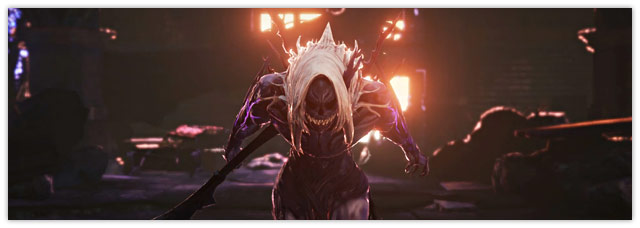
©BANDAI NAMCO Entertainment Inc.
■Yoshimura: We gained a lot of insight into the game as we worked on its action segments.
Balancing and Debugging
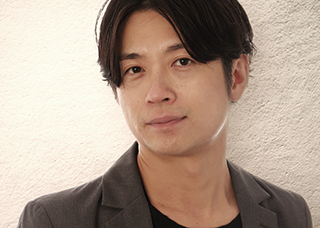
●Hiroshi Yoshimura
Game Designer/CODE VEIN Director, Development Producer
■Yoshimura: We should probably also talk about the last step that gave us a lot of trouble: balancing and debugging. It was… not easy, to say the least. (Laughs)
As you know, we delayed CODE VEIN’s release by a year after announcing its initial release date.
●Yoda: We made the decision to take extra time to polish the game. That entire period was grueling… so much so that we don’t remember any of it. (Laughs)
■Yoshimura: The entire sequence of events was shocking… We worked on debugging so the game would be ready for its launch date. We did everything we could to polish it. After doing all of that, we were told by management that it needs even more improvements before it can be put on sale.
●Yoda: They told us, “You’re gonna have to polish the game. How long will it take?”
■Yoshimura: I told them it would take a year, and they looked at me like I was crazy. (Laughs)
We ended up asking fans to wait a year while we made all sorts of revisions. We felt awful about asking more of everyone involved with the project, but we made the game the best it could be. We practically had to restart the project.
Looking back, while this period was extremely demanding it was also a lot of fun. We got all of our members to look at the game we made and list up anything that wasn’t up to snuff and ended up tweaking huge swaths of the game.
●Yoda: We even changed the order that you encounter each field.
■Yoshimura: We did—we changed the order of the fields, the story’s narrative structure, and even tweaked how difficulty was paced in each field; the changes were really all-encompassing.
●Yoda: And we added more Gifts and more enemies.
■Yoshimura: Mao-kun, it was around this point that you joined, right?
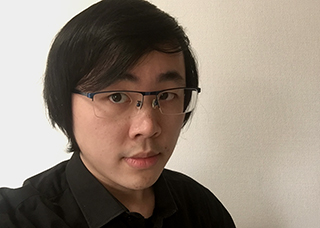
●Dun Mao
Game Designer/CODE VEIN Planner
Game Balance, Localization, and Global Communication Supervisor
●Mao: After the team finished tweaking the game, it felt practically reborn. Adding new mob characters and new action combat-related Gifts gave us a completely different game.
■Yoshimura: I think the changes we made to level design were very effective. We took completed fields and made adjustments according to our reactions to them. Our team discussed what sort of enemies belong next to existing ones, and even re-recorded companion characters’ dialogue.
●Yoda: Right, we added quite a large number of lines.
■Yoshimura: We got a feeling for what each character would say when they enter a specific field, and used that as a guide as we recorded additional dialogue.
●Yoda: We made sizeable additions to the game systems as well. We didn’t even have a mini map at first.
■Yoshimura: We gave the characters additional outfits, too. We spent the extra year working hard to create the new action combat-related Gifts and add new tough enemies; these were the fruits of our labors. It was because we put in this extra work that we were finally able to put the game in players’ hands.
Kobayashi-san, was there anything you had trouble with?
●Kobayashi: I was most closely involved during prototyping so most of what I talk about will be about that phase. I worked on building up the game world while deciding its visual aesthetic, and was tasked with coming up with ideas on my own. Drawing the game world, the backgrounds, the weapons, and the enemies all at the same time was a first for me.
●Itakura: I remember you would say that you’re exhausted from using so many different parts of your brain. (Laughs)
●Kobayashi: I remember that. We were in the middle of starting up the project, and I had my hands full giving trying to explain the direction of the project by preparing documents, showing images, and participating in every meeting. I got a taste of how difficult art direction is. (Laughs)
■Yoshimura: While some of the shapes you used were unusual, the visuals you made back then were really well composed.
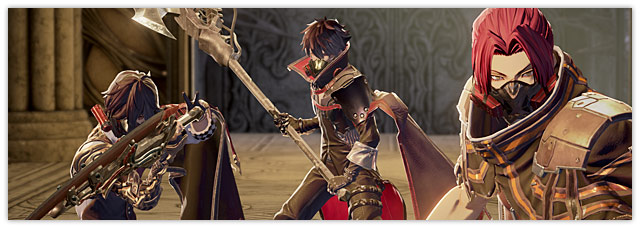
©BANDAI NAMCO Entertainment Inc.
What Staff Kept in Mind during Development
■Yoshimura: Next, let’s talk about what sort of methods everyone devised during development.
●Yoda: I was very careful with making the game’s action combat feel responsive. Considering that this is an action game that branches off of GOD EATER, responsive action combat was a must.
I was especially particular about adding technical elements to make the game’s controls more nuanced. I tucked in hidden elements, like the ability to cancel moves at specific times.
●Itakura: When working with motion capture, were there any details that you tried to get just right?
●Yoda: There were motion capture sequences that looked too human which we had to edit before we could use their animations, but there were also times when we took advantage of human-like parts to spice up other movements. We did a lot of picking and choosing from the materials we recorded as we balanced the game.
One thing we devised related to directing was making alternate encounter animations for bosses after you’ve already fought them. We kept the characters’ personalities in mind, but there are parts that the actors ad-libbed as well.
●Mao: I tried to keep motions from feeling sluggish by taking flinching animations and adjusting them in Unreal® Engine (*1). Localization-wise, the terminology in the original translated text was pretty unorganized, so I paid attention to keeping it consistent to make the text read better.
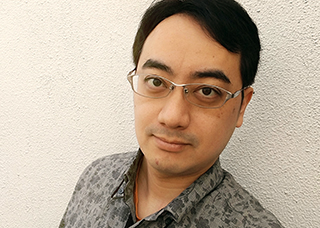
●Koichi Itakura
Artist/CODE VEIN Art Director, Dungeon Building Supervisor
●Itakura: I have three talking points in terms of visual design, the first of which is the Blood Veils’ transformations We were told that Blood Veils shouldn’t transform organically, but instead like they’re driven by artificial mechanisms; we put a lot of thought into how to accomplish this. We ultimately came up with the idea to load them with straps and metal parts. Finally, the thought we put into the costumes paid off and were finally able to progress with their designs.
We don’t get many chances to make titles with vampires, so we wanted to bring that vampire theme front and center through the characters’ various gadgets. Fangs are emblematic of vampires, but in the middle of development we got requests to give characters gas masks. We ended up working as a team to add fang-like details to the characters’ gas masks. I’m personally glad that the characters turned out as well as they did.
■Yoshimura: Agreed.
●Itakura: The third point is the home base’s design. I was involved with arranging the base to fit the feel of Kobayashi-san’s concept art. Ideally, I wanted to recreate her drawings as faithfully as possible.
So I was surprised when the level design we got from the designers was way more spacious than the original concept art.
●Kobayashi: It was practically a cathedral. (Laughs)
●Itakura: We were told that it ended up so large to give the camera room to circle around the character. We wanted it to be more cramped and disorganized, but the more objects we added to fill in the space they gave us, the more it began to look like a boys’ secret clubhouse…
■Yoshimura: So we ended up filling the area with each characters’ prized possessions.
●Itakura: We tried first adding objects that shed light on each characters’ role, and then filling in space with things like exercise equipment, fridges, or pool tables.
■Yoshimura: We even added a motorcycle. (Laughs) I was surprised that the team was able to fill in that cavern of a space.
●Kobayashi: They did an excellent job.
●Itakura: We had fun working on it, and it was worth the effort.
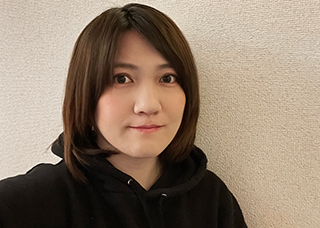
●Kurumi Kobayashi
Artist/CODE VEIN Character Designer, also initial Art Director
●Kobayashi: I had never turned my concept art into such high-resolution character models, so I was particular about how high to set my final goal for them. Of course, my illustrations and the work done by our modeler, Ikeuchi-san, use different styles, but I wanted players to feel that they look consistent even when compared side-by-side. However, the models changed pretty drastically between the prototype and the second evaluation build.
While I never felt unhappy with the work we did during the prototype, I’m glad that we took our work to the next level when creating the first and second builds, and that we didn’t compromise.
■Yoshimura: We discussed that pretty often in the early brainstorming sessions.
●Kobayashi: We did. Development was tough, but times like those were enjoyable and reminded me that I’m glad to work in a creative job.
■Yoshimura: CODE VEIN was the largest scale title I had worked on at that point in time. There were a lot of decisions I couldn’t make by myself, so I relied heavily on the opinions of our development team.
That being said, there were many final decisions that I had to make, and loose ends that I had to tie.
Also, we were adamant from its inception that this title should have a presence in international game markets.
That meant that we couldn’t use the same standards for quality that we had used until that point. We ultimately asked a lot of our team members, but I think that their extra work resulted in a better final product.
One realization I had after the game went on sale was that we should have been more cognizant of how it would stand up to AAA titles. I hope that I can make use of this realization in future titles.
What Staff Gained from Working on the Project and Future Goals
■Yoshimura: Are there things that made everyone glad that they participated in this project, or things that you gained from it?
●Yoda: I was able to work with the latest trends in game development and get involved with the entire process of directing player characters, which made me realize that there are still things that I have yet to experience. It was my first time working on a title aimed at international audiences, and adapting to trends outside of Japan taught me a lot and helped me grow as an artist. It was a great experience for me.
●Mao: Personally, I think we worked very well as a team. I’m glad that we were able to hold casual discussions and that every team member was able to perform at their full potential.
●Itakura: One of our goals was to do a proper job with creating massive dungeons, and I’m glad we were able to accomplish it. We gained a lot of knowledge that I hope we can use in the future.
●Kobayashi: I can relate with what Yoda-san said about learning a lot while working on CODE VEIN. I’m very grateful that I was able to be a part of creating a project of this scale. I think it was a huge success, and I would be happy to use what I learned in the future.
■Yoshimura: There were plenty of struggles along the way, but the thing I’m most happy about is that we were able to glimpse what’s expected of games on the international market. CODE VEIN only gave us a glimpse of how high the bar is set, and I hope that in the future we make an even more remarkable experience.
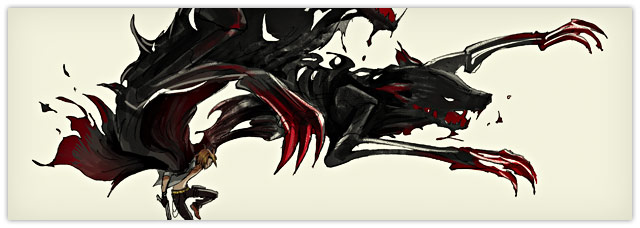
©BANDAI NAMCO Entertainment Inc.
■Yoshimura: I’d like to wrap up by having everyone talk about their goals for the future. Yoda-san, would you mind going first?
●Yoda: I want to work on perfecting a highly responsive and dynamic action combat system and designing battles where the back-and-forth with enemies is enjoyable, all while staying true to the game’s concept. I want to anticipate a breadth of trends in the game industry and give the best output possible at that time.
■Yoshimura: There are definitely trends in action combat systems used in games. Like how to avoid making players overthink certain parts… I can relate to wanting to incorporate those trends.
●Yoda: You’re absolutely right that, if you look at games over the years, there’s been a sharp decrease in unnecessary elements. Designers are constantly re-thinking how to set up their games, and as a designer it’s fun to think about what shape your next game should take.
●Mao: I joined during the second half of the project, and I have a lot of things I want to do. My goal is to understand trends surrounding the PS5, other next-generation consoles, and cloud gaming, and incorporate that knowledge into my work.
●Itakura: Looking back, I wished we could have done more to emphasize the game world’s atmosphere. If I was to make another game, I would want to add even more elements to its appearance. I want to add things like air, which isn’t normally visible, and use it to give more volume to environments or to express certain feelings.
I hope to research how to accomplish an intricate look that goes beyond the strong rim light and contrast we used in CODE VEIN.
●Kobayashi: I want to design characters that could be used in a game sold internationally. While it’s true that there’s international interest in manga-style characters, I would like to use a wider breadth of designs to appeal to an even wider audience.
Also, I want to do a good job with character customization.
■Yoshimura: Fundamentally, I want to create experiences where the player is the protagonist. I want to create thrilling and entertaining experiences that are unlike anything that’s been made so far. I want to pursue that experience, and to be discerning when working on development in order to deliver new emotional experiences to an even wider audience.
I don’t think that there are other veteran teams that have focused solely on games where the player is the protagonist, and I want to treat that as our strength and most important asset, and to maximize its potential.
Official Site
https://www.code-vein.com/
Publisher: BANDAI NAMCO Entertainment
BANDAI NAMCO Entertainment Inc.
The names of companies and products mentioned herein are trademarks or registered trademarks of their respective owners.
(*1)Unreal® is a trademark or registered trademark of Epic Games, Inc. in the United States of America and elsewhere. Unreal® Engine, Copyright 1998 – 2019, Epic Games, Inc. All rights reserved.
「CODE VEIN™」
CODE VEIN™ & ©BANDAI NAMCO Entertainment Inc.




